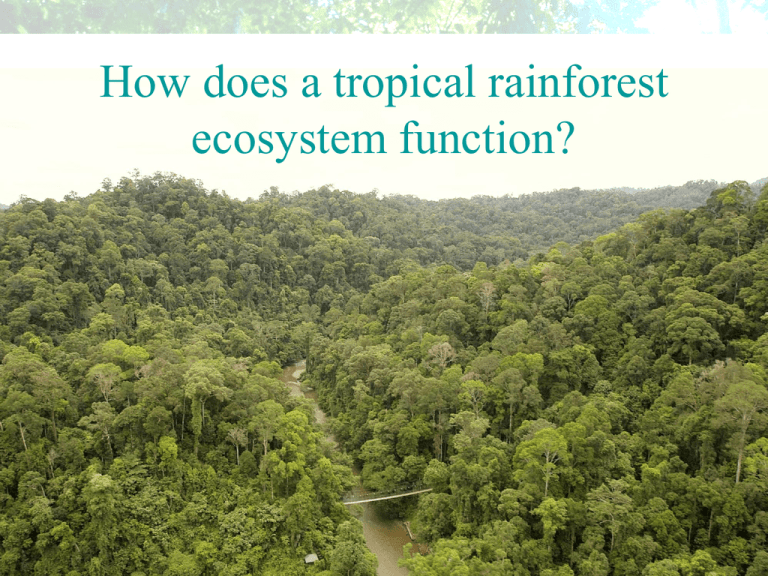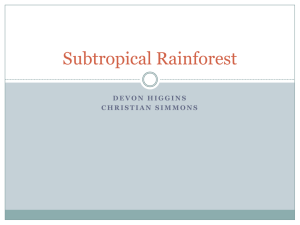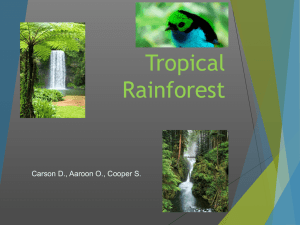TRF 2010c how does t..
advertisement

How does a tropical rainforest ecosystem function? What is an ecosystem? What are the components of an ecosystem? Abiotic components Environment Biotic components Plants Ecosystem Animals What are the biotic components in a tropical rainforest ecosystem? Microscopic organisms Decomposers They may be Consumers Animals Biotic classified into components refer different trophic to living things. (feeding) categories. Producers Plants What are the biotic components in a tropical rainforest ecosystem? 1 Producers Producers are green plants. They can produce their own food by ______________. photosynthesis Carbon dioxide Water at the presence of Sunlight Oxygen Chlorophyll Food What are the biotic components in a tropical rainforest ecosystem? 2 Consumers Tertiary Primary consumers: consumers: Secondary feed directly on Consumers are animals. They cannot feed on secondary consumers: feed on producers produce their own food. consumers primary consumers What are the biotic components in a tropical rainforest ecosystem? 2 Consumers A crocodile eats animals. It is a _________. carnivore A rabbit eats plants only. It classify is a _________. herbivore We can the consumers by their Humansdiet. eat both plants and animals. They are __________. omnivores What are the biotic components in a tropical rainforest ecosystem? 2 Consumers Producers and consumers make up a food chain. A food chain usually starts with a producer and ends with a secondary consumer or tertiary consumer. Rainforest tree (Producer) Grasshopper (Primary consumer) Lizard (Secondary consumer) What are the biotic components in a tropical rainforest ecosystem? 2 Consumers In a tropical rainforest, individual food chains are interlocked at various levels to form a food web. What are the biotic components in a tropical rainforest ecosystem? 3 Decomposers Decomposers such as fungi and bacteria break down dead plant and animal tissues. They secrete _________ enzymes to break down dead organic materials into inorganic matter. Plants can absorb them easily. Fungi are an example of decomposers What are the abiotic components in a tropical rainforest ecosystem? Abiotic components refer to the non-living things. They are found in: Soil Air Precipitation Solar radiation Atmosphere Water at the earth’s surface Underground water Hydrosphere Rocks Lithosphere What are the abiotic components in a tropical rainforest ecosystem? carbon dioxide rivers and lakes oxygen weathered rocks Can you categorize the rainfall solar radiation following abiotic components state Abioticand components their importance to plants and animals? Atmosphere Hydrosphere carbon dioxide rainfall oxygen solar radiation ground water organic materials from soil Lithosphere rivers and lakes ground water weathered rocks organic materials They provide drinking water from soil An They It input provides provide of photosynthesis water nutrients for the to ItAn provides input ofinput moisture thehabitats respiration of the in the of andAn living for soil photosynthesis of plants. plants. ofplants. They provide nutrients for plants. photosynthesis living for the organisms. plants. of animals. How are biotic and abiotic components linked in a tropical rainforest ecosystem? Biotic and abiotic components are closely linked by: Energy flow Nutrient cycling Why is a tropical rainforest a fragile ecosystem? (Credit: K. Wothe/Blickwinkel) This As That mentioned biomass means a is high before, vulnerable proportion most to nutrients various of the energy in disturbances, the tropical and nutrient such as rainforest is stored fires orabove are deforestation. stored ground. in the biomass. Why is a tropical rainforest a fragile ecosystem? (Credit: Joerg Boethling/Still Pictures) As the rainforests support the wildlife there, destroying the rainforest will cause the rainforest ecosystem to collapse. Why is a tropical rainforest a fragile ecosystem? Removal of trees caused by a The biomass stores most of sudden change in climate or the nutrients in a rainforest. external agents Loss of stored nutrients No supply of nutrients to the soil created through decomposition Soil depletion Collapse of the ecosystem Animals die No regrowth of trees Energy flow in a tropical rainforest ecosystem Energy There are flow five istrophic the transfer levelsofinenergy a tropical through rainforest various living ecosystem. organisms along the food web. Input of solar energy T1 Producers T2 Primary consumers T3 Secondary consumers T4 Tertiary consumers T5 Decomposers The sun is the primary source of energy that maintains the ecosystem. Energy is passed along the food chain or food web. Energy flow in a tropical rainforest ecosystem Net input of energy at each tropic level Input of solar energy T1 Producers Energy loss through transpiration or respiration Heat loss through respiration T2 Primary consumers Energy loss through decay and decomposition T3 Secondary consumers T4 Tertiary consumers T5 Decomposers Producers Some energy carry is lost out during photosynthesis the transpiration, with the input respiration of solar and decomposition. energy. Energy flow in a tropical rainforest ecosystem Energy loss through transpiration or respiration Net input of energy at each tropic level Input of solar energy T1 Producers Heat loss through respiration T2 Primary consumers Energy loss through decay and decomposition T3 Secondary consumers T4 Tertiary consumers Energy not being used T5 Decomposers When primary consumers cannot eat the fully producers Since digestas thefood, energy is transferred to of them. producers, the remains the producers are being processed by decomposers. Energy flow in a tropical rainforest ecosystem Input of solar energy Heat loss through respiration Energy loss through transpiration or respiration Net input of energy at each tropic level T1 Producers Energy not being used T2 Primary consumers Energy not being used Energy loss through decay and decomposition T3 Secondary consumers T4 Tertiary consumers Energy not being used T5 Decomposers energy the flowtropic carries on (except at different tropic levels. The higher level decomposers), the ( less / more ) the energy remains. Trophic pyramid A trophic pyramid shows the amount of organic matter of the living organisms in an area. As the trophic level increases, the amount of organic matter of each tropic level ( decreases / increases ). Nutrient cycling in a tropical rainforest ecosystem Nutrient cycle refers to the circulation of nutrients from the environment to organisms and back to the environment. Environment Biomass Organisms Litter Nutrients are circulated among three stores Soil Nutrient cycling in a tropical rainforest ecosystem Amount of nutrients A Biomass transferred Biomass refers to the total weight of living organisms, i.e. plants and animals, of an area. Nutrients are stored in plants and animals. Plants consume nutrients from the soil and sun’s energy to produce their own tissues through photosynthesis. When animals eat plants, they take up the nutrients and convert plant tissues to their own tissues. Biomass Uptake by plants Soil Nutrient cycling in a tropical rainforest ecosystem Amount of nutrients B Litter Litter transferred Littering Biomass Dead plants tissues, dead animals and animal wastes accumulate on the ground to form a layer of litter. The falling rain dissolves minerals, e.g. nitrogen and carbon in the air, and add the nutrients to the litter. Some of the nutrients may be washed away by run-off. Nutrient cycling in a tropical rainforest ecosystem Amount of nutrients C Soil Litter transferred Nutrients decomposed from litter Soil Input from weathered rock When litter is decomposed, the nutrients are broken down into inorganic form and stored in the soil. Weathering of rocks contributes nutrients to the soil. Nutrients of soil may lose through leaching. Nutrient cycling in a tropical rainforest ecosystem In tropical rainforests, the nutrient store of biomass is huge, but the stores in soil and litter are small. Most nutrients are stored in the dense vegetation Much input from rainfall Litter Biomass Quick uptake by plants Litter is quickly decomposed Soil Amount of nutrients transferred Heavy rain causes strong leaching






